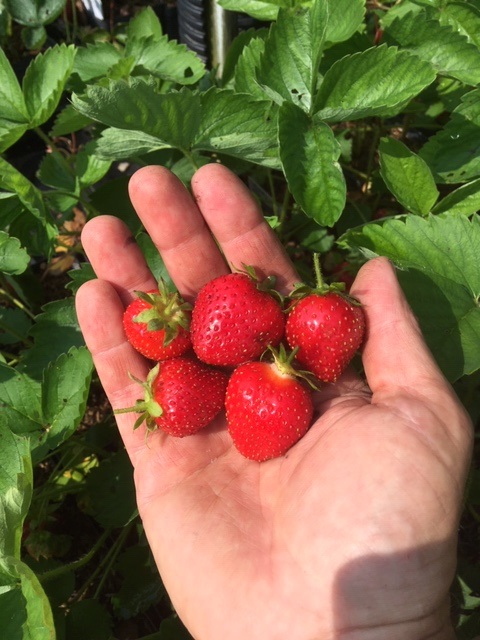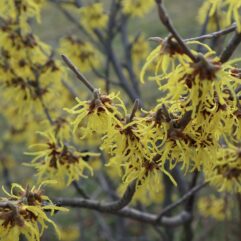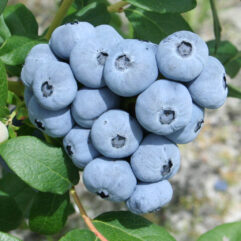

Strawberries
Strawberries can be an enjoyable berry to grow.
Of course, anytime a juicy, sweet fruit grows close to the ground, one should take some extra precautions. Most all of the diseases associated with strawberry production can be controlled with cultural methods (no spraying).
In my experience with strawberries, these are the key factors to reduce leaf and fruit diseases:
Air circulation
Wider planting distances
Elevated or raised bed planting
Drip irrigation / soaker hoses
Low nitrogen, organic fertilizers
Index of Care Topics
Where to Plant Strawberries
How Far Apart to Plant Strawberries
Soil Amendments for Strawberries
Fertilizing Strawberries
Winter Care
Helpful Products for Growing Strawberries Organically
Where to plant your organic strawberries
Raised Beds
I’d have to say that raised bed, intensive growing has done more for my strawberry production than anything other action I’ve taken. The soil is lighter in a raised bed, and the benefit of that in my Midwestern climate is that the usually heavy spring rains drain away quickly. This keeps soil pathogens from getting a foothold on the strawberries, and also eliminates standing water in the growing area. Keeping the soil moist and not sodden is very important for insuring consistent, heavy yields from your strawberry plants. I’d suggest at least a 6″ above grade height for your raised beds.
Planters and Large Pots
Potted culture has also worked well for day-neutral cultivars, and I have a number of different pot sizes with which I work. These have allowed me to move them around so they can get shade or more sun when they need it, or rolled into a cold frame or greenhouse when weather gets frosty in the fall, thereby extending my picking season.
Raised Bed Soils and Irrigation
There are many recipes for mixing up raised bed planting soils. Most work well, and I’d suggest that the importance is that they have a good amount of organic matter (like sphagnum peat; aged, weed free compost; leaf mold), upwards of 40-60% of the total volume. Since you don’t cultivate in a raised bed, you can put down a good drip line under the mulch. Using drip lines gets water to the roots, and keeps it off of the berries and leaves, reducing the chance of diseases. Some growers I know have erected a frame over their strawberry beds, which is open on the sides, but has span of clear grow film over the top, to disperse rain water away from the bed. These plants rarely get any water on their leaves, and the plants look great and yield very well, with no sprays of any kind.
The raised bed offers increased air circulation (it is above the ground); increased drainage during wet times of year (which are usually the times the June-bearing cultivars are trying to make their berries); and a chance to use drip lines effectively in a non-cultivated, mulched growing area.
How Far Apart to Plant Organic Strawberries
For June-bearing strawberries, I plant into a raised bed that is no wider than 4 feet. The spacing is 12″ O.C. (on center), and I sometimes use staggered rows. For some cultivars, like Cavendish and Cabot, which make very large to huge berries, I will go a little wider, to 16″ O.C. I’ve also found that to be a good spacing for Seascape (a day-neutral). The Alpines I space 12″ apart in a bed. I also keep runners pruned out of all the day-neutral beds, and divide their crowns every 3-4 years, depending upon the cultivar and size of plant.
For June-bearing strawberries I allow only 4-5 runners per mother plant to root into the bed. These rooted plantlets are transplanted to new beds the following year, keeping the spacing and area clean for the June-bearing plants. These mother plants can be replaced every 3 years (at which point they have reached their maximum potential, and will decline in yield) with new 1 year plants generated as runners the previous year.
What to add to the soil when planting organic strawberries
When planting strawberries into a raised bed or planter, I like to add a few amendments to help with onward growth and production of the plant. Regardless of the type of strawberry (June-bearing or day-neutral), I always add these amendments when planting.
For each plant, add a Tbsp of soft rock phosphate (optional if you are using Neptune’s Harvest liquid fish during the growing season), 2 Tbsp kelp meal, and 4 Tbsp alfalfa meal. If you have it, you can also add a cup of compost or a half cup of worm castings per plant. Most of these amendments do more directly for the beneficial soil organisms than the strawberry plant, but then the old saw, “Healthy soil, healthy plant” is quite true in my experience.
I mentioned low nitrogen fertilizers above, and that is important, because it is very easy to get too much available nitrogen in the soil. When this happens, plant growth accelerates to un-healthy rates, and becomes very accommodating for bacterial, fungal, and insect pests. The plants natural immune system is essentially compromised during exposure to high nitrogen fertilizers, which is why so many toxic sprays are needed in chemical growing of fruits.
Fertilizing Strawberries
I no longer use granular fertilizers on our crops. I have switched all of our berries and veggies over to a liquid fertility schedule. While this is more involved, I have found it to be quite worthwhile as regards the quality and yield of the crop. For strawberries, I follow a slightly lower mix ratio from what is listed on our Plant Care page. It is listed here as follows:
To 1 gallon water, add 1 Tbsp Neptune’s Harvest (2-4-1) OR 1 Tbsp Alaska Liquid Fish (5-1-1) which is better to be used in summer and hot temperatures,
1/2 Tbsp liquid kelp, and 1/2 Tbsp blackstrap molasses (yes, from the grocery store).
I apply this twice a month during flowering in spring, then when fruit set begins, I drop the Neptune’s or Alaska from the mix, and apply just kelp and molasses every 2 weeks until fruiting is done (for June-bearing). After fruiting is done, I give them the full mix once a month until October, or the daytime temps drop below 50 consistently.
For day-neutrals, which fruit all during spring, summer, and fall, they need more nutrient support to their soils. I feed them once a week at a half rate during their fruiting season, and that keeps the berry size up, and the blossoms coming. NOTE: Do not spray foliage of strawberries with the liquid fish brew when temps are going to be above 80F, as the oil in the mixture may scorch leaves (especially sensitive are the alpines).
When fall comes, I stop giving them any fertilizer, unless I’m doing season extension in a cold-frame or greenhouse, and then they get the fertilizer brew once every three weeks into early winter.
Winter Care
Strawberries got their name because straw was a great mulch for them. I don’t like to use non-organic straw on berries (especially berries that are resting on the straw), but they do need a mulch over the winter to protect them from desiccating freezes.
I’ve used chopped leaves, but wasn’t happy with the yields where I used it, and the small bits of leaf stick to the berries and plants, creating wet spots that don’t dry well. That led to increased disease presence in the bed. Grass clippings are out, and hay too, as they are just packed with weed seeds. I have had good luck using pine bark mini-nuggets as a mulch around the strawberries, as it dries fast and doesn’t soak up water. However, it is too heavy to use as a mulch over the plants, and too expensive.
What I use currently is a 3 oz. (or a doubled 1.5 oz) frost/freeze blanket. It comes in a handy roll, and lasts a few winters if you roll it up promptly when spring arrives. Survival and flower bud initiation has been excellent, and I never feel like I have to rush out to get the straw off during a wet, rainy period in late winter. Very easy to use, and the blanket protects the plants from winter exposure.
I think, if one were looking for an environmentally friendly cover, a few layers of burlap would work, especially if you had a good cover of snow for most of the winter.
Helpful Products for
growing Strawberries Organically
Your hands are best, and keeping the plants thinned out so they get enough air flow around them. But, sometimes all the work and planning don’t pan out, and you need to do something to save a crop or stop a disease from wiping out your plants. Healthy soil really is your best defense, but things with weather and temperatures can occur that will afflict even the healthiest plants. When I know some nasty, cold, rainy weather is going to roll in on my strawberries when they are loaded with ripening fruit, or trying to bloom, I have used Neem oil to great effect. It is sold under different labels, I use one called Trilogy (sold by Ohio Earth Food). Neem oil is non-toxic to most animals (as an oil, it does kill scale, mites, and soft bodied insects), though it does act as a repellent for most scarab beetles (like the Japanese beetle). It is also a very effective fungicide and bactericide, and it is for these properties I use it. Different brands and formulations have varying application rates, but generally it is once a week during the times you expect problems.
There are some other OMRI listed products with which I have less experience: Serenade, Actinovate, GreenCure (a sodium bicarb based fungicide), and Oxidate (a hydrogen dioxide based fungicide). Ohio Earth Food and Johnny’s Select Seeds offer these products.




